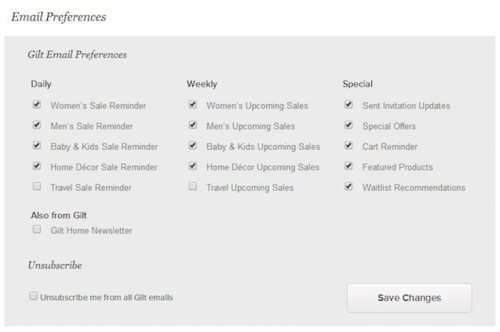By Jason Trout, VP of Marketing, ShoppinPal

In retail, even the best intentions can result in customer dissatisfaction. Policies to prevent fraud can lead to shoppers thinking you’re inflexible, for instance. Or your associates’ efforts to be helpful can be mistaken for them being too salesy. In this post, we’ll look at four common retail mistakes that are costing you customers. Check them out below and see if you’re committing them in your business.
1. One-Size-Fits-All Email Content And Frequency
While email is a known best practice when it comes to keeping in touch with customers and driving traffic, misusing the medium can do more harm than good.
Multiple surveys, including ones from Constant Contact and Campaign Monitor, have found that the top two reasons why users unsubscribe from a list are too many emails and irrelevant messages.
So how can you prevent pissing off your email subscribers? Ensure that your emails are seen by the right users by segmenting them into relevant groups, then tailoring messages accordingly.
Another way is to let your subscribers set their own preferences when it comes to email content and frequency.

Gilt, for instance, allows users to specify whether they wish to receive daily, weekly or only special messages. Subscribers can also filter emails according to their location and types of deals they wish to receive.
2. Poor Staff Quality And Quantity
There’s a line between being helpful and aloof, and in retail, that line varies from one customer to the next. Associates who fail to read each customer can immediately ruin the relationship and send shoppers packing.
That’s why store management must train staff to pay attention and tailor their approach to how each customer behaves. Some people may want to be guided and waited on, while others prefer a more independent shopping experience.
Also be mindful of the quantity of associates in your store. Not enough people can result in insufficient customer assistance, while having too many of them on the floor at a time can disrupt the shopping experience.
To address this, use in-store analytics tools to determine how to staff your locations. Godiva, for instance, uses people counters to figure out peak traffic hours so it can staff its branches accordingly.
3. Strict Return Policies
Returns are every retailer’s nightmare. And with retailers losing $8.76 billion to fraudulent returns alone, it’s only fair that merchants implement rules to prevent abuse or fraud. Just make sure your rules aren’t too inflexible. Having “no return, no exchange” policies or requiring customers to pay restocking fees are surefire ways to lose them for good.
Consider what happened to Williams-Sonoma. In an interview with TIME magazine, a former customer shared how disappointed she felt when the retailer refused to honor her return request because she didn’t have a gift receipt. She’d been shopping with them for years and the fact that they wouldn’t take back the product made her feel betrayed. She didn’t shop with them after that.
The “point of no return” is a moving target. Yes, you should have some guidelines in place, but ultimately, how you handle returns should be a case-by-case basis.
Nordstrom, for instance, recognizes that these situations aren’t cut and dry, so it empowers its employees to use their own judgment when accepting returns. Why not do the same thing in your store? Let your employees consider factors such as the reasons for the return, the customer’s relationship with the business, among others, before making a final decision.
It’s also a good idea to be a bit more lenient during and after the holidays. Apple and Best Buy extend their holiday return policies because they know that people are busy during the holidays and some shoppers purchase gifts early.
4. Long Lines
Want people to walk out, or worse, turn the other way before even setting foot in your store? Scare them away with long lines. According to a study, “retailers are losing up to 39% of revenues due to long lines and in-line frustration.”
Explore different ways to speed up the checkout process. Analyze in-store traffic and staff your registers based on traffic data. That’s what Kroger did last year. The grocery chain installed overhead infrared sensors that counted customers in all its branches. This enabled Kroger to analyze its peak shopping times so it could improve staffing its registers.
According to USA Today, “Customers can see the results of this data changing constantly on light boards at the front of stores. They show the number of checkout lanes in service now, the number needed, and the number projected to be needed in 30 minutes.”
Making use of mobile POS systems can also streamline the checkout process with their portability and additional capabilities, such as the ability to email receipts and accept mobile or contactless payments. Stores like Apple, Home Depot, and even a number of small retailers are using the technology, and if you haven’t done so yet, you should really consider following suit.
Jason is the Vice President of Marketing at ShoppinPal, a mobile shopping platform for retail stores. Integrated with retail point-of-sale systems, ShoppinPal is designed to increase foot traffic and repeat purchases through product recommendations, targeted rewards and mobile checkout.






